Physical Address
304 North Cardinal St.
Dorchester Center, MA 02124
Pathological examination of the placenta may provide useful information regarding the underlying mechanisms of a range of pregnancy complications that may guide future management and improve understanding of disease pathophysiology.
Placentas should be submitted for examination by specialist pathologists in all complicated pregnancies according to national and local guidelines.
Interpretation of the clinical significance of many placental histologic changes remains difficult, and novel approaches are required for future development in addition to traditional histologic evaluation.
Paraffin-embedded tissue blocks are stable for many years at room temperature and thus may be transferred to tertiary pathology centres if required for reassessment, using additional histologic or DNA methods, and may also be used for medicolegal assessment of disease causation.
Placental evaluation should be encouraged in all cases of intrauterine death, regardless of whether formal postmortem fetal examination is requested.
It has long been recognised that a wide range of disorders of pregnancy are related to changes affecting the placenta, and our understanding of the underlying mechanisms of many obstetric diseases, such as fetal growth restriction (FGR) and preeclampsia, is largely derived from pathological studies of the delivered placenta. With this in mind, the potential benefits of a specialised placental pathology service include improved evaluation of pathophysiological processes in specific cases, which may affect subsequent management and recurrence risk, and as a source of material for subsequent research. This chapter provides an overview of the role of placental pathological assessment in modern fetal medicine, with examples in relation to antenatal diagnosis, and suggests how this area may develop in the near future. Extensive literature is available regarding details of specific placental pathologies in specialist texts.
The yield of significant abnormal findings from placental pathology examination is related to the underlying clinical circumstances, and there are therefore several recommendations published regarding indications for formal placental pathological evaluation. These largely include all preterm deliveries and otherwise complicated pregnancies, either associated with maternal or fetal diseases, acute compromise to fetal health or admission to the neonatal intensive care unit (NICU). This policy results in examination of around 10% of placentas from unselected low-risk pregnancies, a proportion that will obviously be much greater in tertiary referral fetal medicine centres. In addition, protocols exist describing the suggested examination approach, including macroscopic assessment, tissue sampling and subsequent histologic evaluation to form an overall diagnostic opinion.
In the majority of cases examined as part of clinical practice, sampling of the umbilical cord, membranes and placental parenchyma (normal and abnormal), including any lesions, takes place after a period of fixation, with subsequent processing and histologic evaluation of haematoxylin and eosin–stained slides from each tissue sample. Large placental tissue diagnostic archives are therefore available but are limited by being composed primarily of formalin-fixed paraffin-embedded (FFPE) blocks and slides rather than frozen material that is typically obtained from fresh tissue. With the introduction of novel methods of future investigation, it is likely that routine storage of fresh placenta samples taken immediately at delivery may be required for analysis (typically for protein, metabolite or RNA studies), with obvious resource implications.
Placental histologic sections are evaluated and the findings interpreted in the context of details in the clinical history such as gestational age, pregnancy complications, birth details and the initial gross placental findings ( Fig. 9.1 ). In this regard, placental pathology reporting is in many ways more challenging than other areas such as tumour pathology because there are few placental histologic changes that are pathognomonic of a specific disease; rather, interpretation is based upon constellations of features in relation to the clinical features that are statistically associated with particular clinical presentations. Placental features are therefore helpful for determining the broad mechanisms of underlying pathological processes leading to overt clinical manifestations so as to improve our understanding of the pathogenesis of a variety of complications of pregnancy (e.g., early- and late-onset preeclampsia, in which maternal factors can considerably affect the risk for disease).
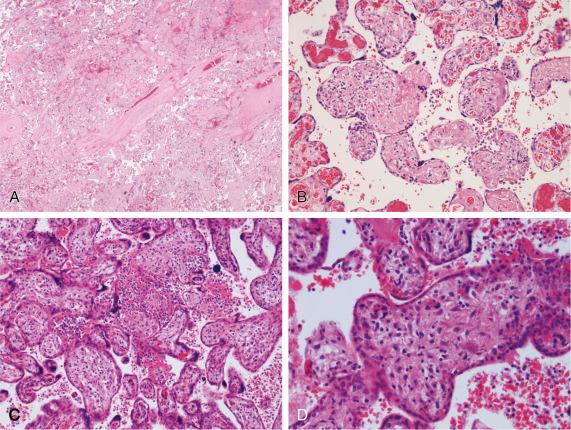
However, because histologic evaluation involves subjective assessment, a relationship exists between pathologist expertise or experience and placental reporting utility; 40% of placental cases reported by nonspecialist pathologists were erroneous compared with subspecialty assessment, including omissions and false-positive findings. It is therefore recommended that multidisciplinary placental teams are established in specialist centres, with close interaction of the obstetric and perinatal pathology reporting staff, and regular discussion of findings in relation to both antenatal ultrasound findings and clinical outcomes. It is hoped that recent efforts regarding consensus statements for placental reporting will reduce interpathologist variability and allow improved studies of interpretation.
The ability to identify pregnancies with, or at risk for, a range of placental pathologies has advanced considerably over the past 30 years, with the application of both real-time and colour Doppler ultrasound to evaluate both the placenta and its maternal and fetal circulations. The definitive placenta is formed by the end of the first trimester, such that many aspects of gross anatomy, such as shape, size, cord insertion and implantation site, can be determined from the first trimester, using either simple two-dimensional methods or three-dimensional volume assessment. During the second trimester, the placenta is larger and thus easier to assess using abdominal ultrasound imaging including Doppler assessment of the uteroplacental circulation ( Figs. 9.2 to 9.4 ).
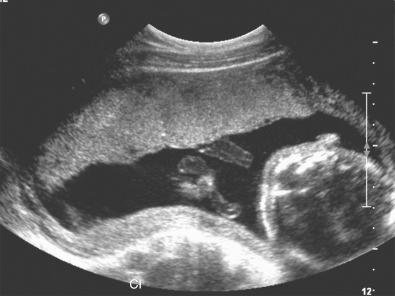
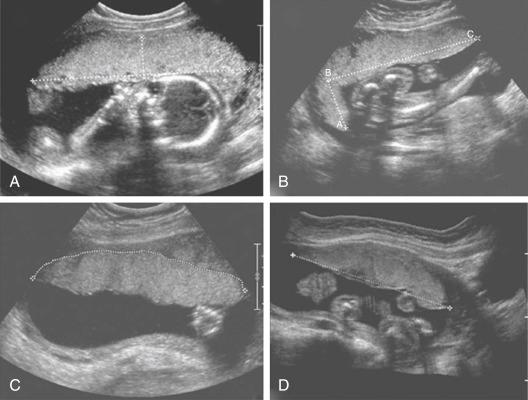
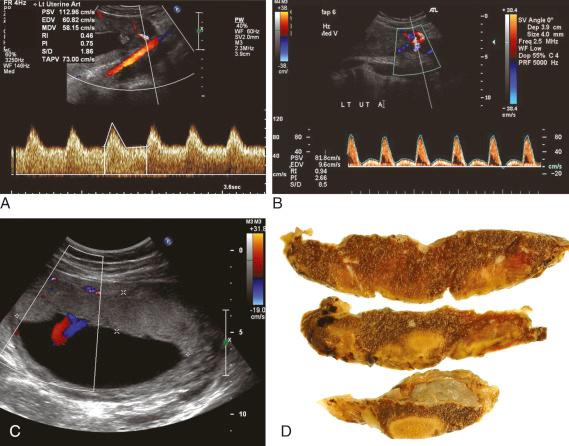
Because maternal vascular malperfusion (MVM) is the most common type of placental pathology associated with early-onset preeclampsia and FGR, screening programs to identify women at most risk have focused on incorporating uterine artery Doppler studies into screening algorithms that include clinical risk scores and biomarkers, such as serum placenta growth factor (PlGF). This combined approach has the potential to provide improved precision in screening for both preventable stillbirth caused by placental disease and FGR, although to date, no interventions have delivered improved perinatal outcome.
Many large-scale research screening programs such as those referenced lack placental pathology findings, which is understandable because of the associated cost per case. However, the inherent variability in underlying placental pathophysiology associated with stillbirth and FGR has the potential to confound the accuracy of screening. Uterine artery Doppler may predict the placental features associated with MVM; however, in a study of severe early-onset FGR pregnancies with abnormal umbilical artery Doppler, 10% had normal uterine artery Doppler studies; these had a greater risk for placental diseases unrelated to MVM but with significant recurrence rates (e.g., chronic histiocytic intervillositis (CHI) and massive perivillous fibrin deposition).
It has further been suggested that many placentas from early-onset FGR or preeclampsia exhibit abnormalities of size, shape, cord insertion or parenchyma, which may be detectable antenatally. For example, ‘chorion regression’ may be associated with a ‘jelly-like’ hyperinflated placenta, and several specific placental pathologies have sonographically identifiable features. However, the role of ‘placental sonography’ beyond individual case assessment remains uncertain. Illustrative examples of the role of placental sonography in identifying pathologies of the placenta, umbilical cord and membranes are provided ( Figs. 9.5 and 9.6 and ![]() ).
).
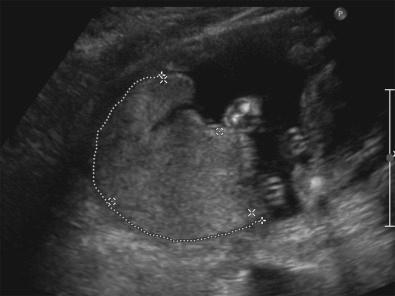
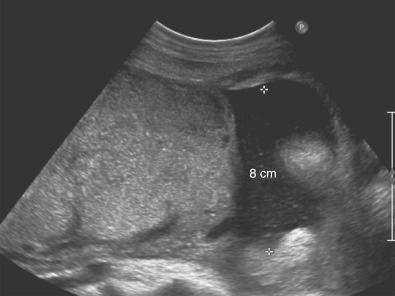
One of the historical difficulties of interpreting literature relating to placental pathology has been inconsistent use of terminologies by clinicians, scientists and pathologists and use of multiple labels for the same entity. To address this issue, there have been recent collaborative approaches to unify the use of terminology. The currently recommended classification system is being used in this chapter ( Box 9.1 ).
Some placental lesions demonstrate characteristic and unique histologic features, allowing definitive diagnosis regardless of clinical circumstances or other factors. However, such entities represent only a minority of histologic changes identified in the placenta, with the majority of lesions also being encountered in clinically uncomplicated normal pregnancies, although being more or less frequent in association with specific pregnancy complications. This overlap results in consistent data describing risks or odds ratios for the strength of association among specific histologic features and specific obstetric disorders on a population basis, but accurate interpretation of the clinical significance of specific findings in an individual case is fraught with difficulties. The details provided summarise the available data but should be interpreted with these above in mind.
In this section, entities which are relatively common or important are described, focusing particularly on their relationship to antenatal detection and management of common clinical conditions. Extensive literature is available providing details of the full spectrum of pathologies. The categories broadly map to Box 9.1 but for ease of discussion are described in terms of their mechanisms and clinical significance.
Maternal stromal-vascular lesions
Malperfusion (including distal villous hypoplasia, accelerated villous maturation and infarct)
Loss of integrity (including abruptio placenta and marginal abruption)
Fetal stromal-vascular lesions
Developmental (including delayed villous maturation and dysmorphic villi)
Malperfusion (including global and segmental lesions)
Loss of integrity (including fetal haemorrhage and fetomaternal haemorrhage)
Infectious inflammatory lesions
Acute (including maternal and fetal inflammatory responses)
Chronic (including villitis and intervillositis)
Immune or idiopathic inflammatory lesions
Including villitis of unknown aetiology (chronic villitis, chronic chorioamnionitis, lymphoplasmacytic deciduitis, eosinophil T-cell fetal vasculitis) and chronic histiocytic intervillositis
Massive perivillous fibrin(oid) deposition (maternal floor infarction)
Morbidly adherent placentas (accreta)
Meconium-associated changes
Become a Clinical Tree membership for Full access and enjoy Unlimited articles
If you are a member. Log in here